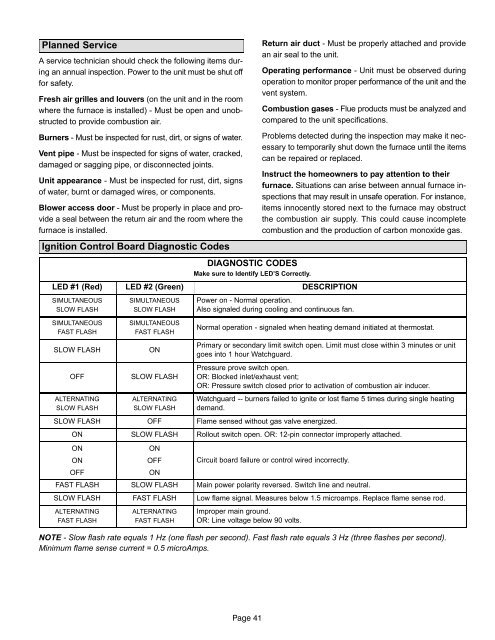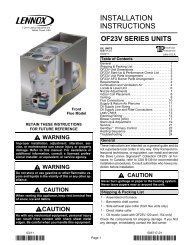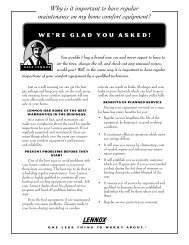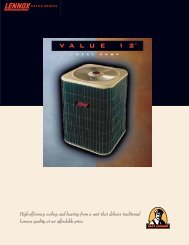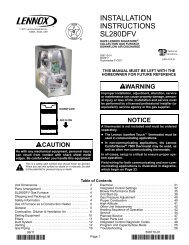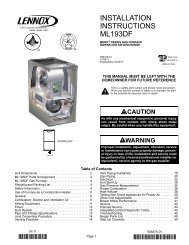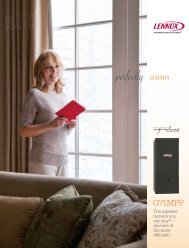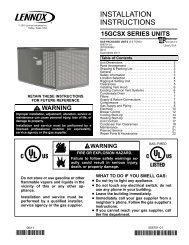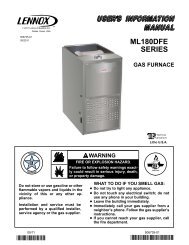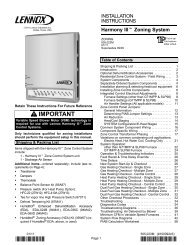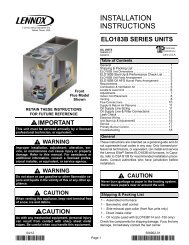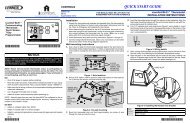INSTALLATION INSTRUCTIONS - Lennox
INSTALLATION INSTRUCTIONS - Lennox
INSTALLATION INSTRUCTIONS - Lennox
Create successful ePaper yourself
Turn your PDF publications into a flip-book with our unique Google optimized e-Paper software.
Planned Service<br />
A service technician should check the following items during<br />
an annual inspection. Power to the unit must be shut off<br />
for safety.<br />
Fresh air grilles and louvers (on the unit and in the room<br />
where the furnace is installed) − Must be open and unobstructed<br />
to provide combustion air.<br />
Burners − Must be inspected for rust, dirt, or signs of water.<br />
Vent pipe − Must be inspected for signs of water, cracked,<br />
damaged or sagging pipe, or disconnected joints.<br />
Unit appearance − Must be inspected for rust, dirt, signs<br />
of water, burnt or damaged wires, or components.<br />
Blower access door − Must be properly in place and provide<br />
a seal between the return air and the room where the<br />
furnace is installed.<br />
Ignition Control Board Diagnostic Codes<br />
DIAGNOSTIC CODES<br />
Make sure to Identify LED’S Correctly.<br />
LED #1 (Red) LED #2 (Green) DESCRIPTION<br />
SIMULTANEOUS<br />
SLOW FLASH<br />
SIMULTANEOUS<br />
FAST FLASH<br />
SLOW FLASH<br />
OFF<br />
ALTERNATING<br />
SLOW FLASH<br />
SIMULTANEOUS<br />
SLOW FLASH<br />
SIMULTANEOUS<br />
FAST FLASH<br />
ON<br />
SLOW FLASH<br />
ALTERNATING<br />
SLOW FLASH<br />
Return air duct − Must be properly attached and provide<br />
an air seal to the unit.<br />
Operating performance − Unit must be observed during<br />
operation to monitor proper performance of the unit and the<br />
vent system.<br />
Combustion gases − Flue products must be analyzed and<br />
compared to the unit specifications.<br />
Problems detected during the inspection may make it necessary<br />
to temporarily shut down the furnace until the items<br />
can be repaired or replaced.<br />
Instruct the homeowners to pay attention to their<br />
furnace. Situations can arise between annual furnace inspections<br />
that may result in unsafe operation. For instance,<br />
items innocently stored next to the furnace may obstruct<br />
the combustion air supply. This could cause incomplete<br />
combustion and the production of carbon monoxide gas.<br />
Power on − Normal operation.<br />
Also signaled during cooling and continuous fan.<br />
Normal operation − signaled when heating demand initiated at thermostat.<br />
Primary or secondary limit switch open. Limit must close within 3 minutes or unit<br />
goes into 1 hour Watchguard.<br />
Pressure prove switch open.<br />
OR: Blocked inlet/exhaust vent;<br />
OR: Pressure switch closed prior to activation of combustion air inducer.<br />
Watchguard −− burners failed to ignite or lost flame 5 times during single heating<br />
demand.<br />
SLOW FLASH OFF Flame sensed without gas valve energized.<br />
ON SLOW FLASH Rollout switch open. OR: 12-pin connector improperly attached.<br />
ON<br />
ON<br />
ON<br />
OFF Circuit board failure or control wired incorrectly.<br />
OFF<br />
ON<br />
FAST FLASH SLOW FLASH Main power polarity reversed. Switch line and neutral.<br />
SLOW FLASH FAST FLASH Low flame signal. Measures below 1.5 microamps. Replace flame sense rod.<br />
ALTERNATING<br />
FAST FLASH<br />
ALTERNATING<br />
FAST FLASH<br />
Improper main ground.<br />
OR: Line voltage below 90 volts.<br />
NOTE − Slow flash rate equals 1 Hz (one flash per second). Fast flash rate equals 3 Hz (three flashes per second).<br />
Minimum flame sense current = 0.5 microAmps.<br />
Page 41


